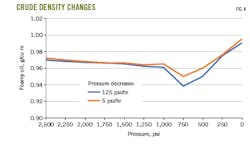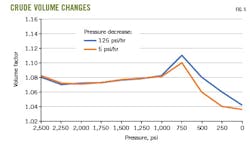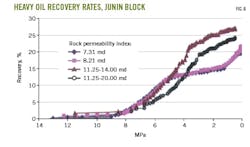Fu Jin
Wang Xi
Liu Bingshan
Fang Zhimeng
Chen Chen
Petrochina Research Institute of Petroleum
Exploration and Development
CNPC Drilling Research Institute
Beijing
CNPC researched optimal horizontal well spacing and best production practices in Venezuela's Orinoco belt, which produces heavy oil known as foamy oil. This oil is characterized by high viscosity, a low gas-to-oil ratio during production, and a slow production decline rate compared with conventional heavy oil.
Numerous Canadian and Venezuelan heavy oil wells produce a stable, thick oil-gas foam under solution gas drive. Authors examined pressure, volume, and temperature (PVT) measurements from laboratory testing and a pilot well in the Orinoco's northern Junin block, operated by CNPC.
Laterals of 800-1,200 m spaced 500-600 m apart yielded maximum initial production of 1,500 b/d. Cold production of heavy oil causes high-porosity channels called wormholes. Sand and oil are simultaneously produced during cold production.
Experiments proved recovery rates improved as formation permeability increased. Sand extraction creates a wormhole network through which foamy oil flows.
The Orinoco is one of the least developed heavy oil regions worldwide. Fig. 1 shows four Orinoco zones that state-owned Petroleos de Venezuela SA (PDVSA) has delineated based on tectonics and sedimentary characteristics.
PDVSA reports only 4% of the area and 11% of original oil in place (OOIP) has been developed. The Cretaceous northern Junin block produces 20° API gravity oil, which drops to 6° in southern Junin block. Oil viscosity is 2 pascal per sec (Pa·sec) in the northern block, increasing to 5 Pa·sec in the southern block. Natural asphalts, sulfurs, and alums are widely distributed. Viscosity drops with greater depth.
Well pad development
CNPC optimized pad patterns based on previous experience from Niger Agadi oil field. The table shows Junin lateral lengths and recovery rates in a 36-m pay zone. Laterals of 800-1,600 m prolonged stable production and improved cumulative production/well compared with 600-m laterals. But recovery improvement stopped with laterals longer than 1,600 m.
Relative position of the wellhead and drilling target affect borehole trajectory and total depth. CNPC's Junin development proposal calls for three-dimensional wells. Well E3-23, the pilot well, was 1,984 m TD with 372 m TVD and a horizontal displacement of 1,688.5 m.
Fig. 2 shows the optimized trajectory and lateral placements for a Junin 4 pad with eight horizontal wells. Fig. 3 shows the borehole trajectory. Engineers recommend using a pendulum bottomhole assembly (BHA) to help control well deviation.
The angle-building interval at 46-450 m depth involves a 70° deviation over 155 m with an average build up rate of 6°/30 m. Drilling engineers increased the angle in the second interval to a well deviation landing point of 87° with an azimuth change of 3-5°. Engineers increased the angle in a third drilling interval to 90°.
They tested the reservoir's lower boundary using pad-based horizontal wells and rotary steerable drilling to control landing points and horizontal sections in real time. The experiment demonstrated improved recovery rates with increased formation permeability stemming from the creation of wormholes.
Researchers recommend using a 16-in. bit for boreholes, extensive perforations, and slotted liners.
Drilling crews monitor well positions when trajectories are 30 m apart to avoid collisions. Factory-style drilling can improve operational efficiency, the same interval on each well using the same mud system and cement slurry.
Foamy oil flow
Foamy oil, unlike conventional heavy oil, contains dispersant bubbles that reduce viscosity and require more energy to extract. Heavy oil's viscous force is higher than its gravity and capillary force so microscopic bubbles persist in foamy oil. The bubbles accumulate and expand.
Computer simulations of Orinoco cold production demonstrated:
• Numerous bubbles adhere to pores to lubricate heavy oil flow channels and reduce flow resistance.
• Micro bubbles in foam reduce oil viscosity and improve oil fluidity.
• Foams optimize oil compressibility and improve elastic energy.
• Gas bubbles dispersed in oil combine with each other, yielding critical gas saturation and enabling gas flow through an intermittent phase. Formation pressure falls slowly, which extends cold production duration.
Researchers used a capillary viscometer to measure pressure, temperatures, and flow patterns. A rotary viscometer was not used because its rotation leads to gas discharge that can yield incorrect viscosity readings.
Simulations used pressures and temperatures based on Junin block readings. For the pilot, crews injected gas for 1 day and then shut in the well for 2 weeks to balance the oil and gases.
A pseudo-bubble point exists between the foamy oil flow model and the dissolved gas flow model. Gas in a conventional model accumulates rapidly upon reaching the bubble point and enters a constant gas phase.
Gases disperse in foamy oil flow before reaching critical pressure or the pseudo-bubble point, the pressure point at which microscopic gas bubbles accumulate and form a constant gas phase in foamy oil.
Foamy oil's volume and density change at various pressure drop rates. The changes become more obvious at 125 psi/hr than at 5 psi/hr. The two breakpoints are bubbling pressure and pseudo-bubble pressure.
Fig. 4 shows the bubble point of Junin oil is 980 psi. Oil density and volume factor change little with the pressure drop before the bubbling point because all gases are dissolved in crude oil. Fig. 5 shows the pseudo-bubble point of 745 psi.
Researchers observed foam in a microcosmic simulation device, revealing the complete cycle of foam formation, accumulation, and depletion.
Foams gather and maintain a constant gas phase. Bubbles move toward each other. A channel connects the bubbles when surrounding gases reach critical gas saturation. Bubbles start flowing upon exceeding critical gas saturation. Meanwhile, viscous and capillary forces continuously break down foams.
Gas displacement features
Gas phases in a normal gas drive consist of dissolved gases and free gases. Foamy oil contains oil and dispersed gases. Gases completely dissolve in oil phases while free gases move faster than dispersed gases.
Dissolved gases become dispersed gases in heavy oil before becoming free gases. Heavy oil production involves three phases, starting with a single-phase flow pattern in which reservoir pressure is greater than bubbling point pressure.
As formation pressure gradually decreases, the gas-to-oil ratio (GOR) resembles the original dissolved GOR. First-phase recovery is 2%.
Dissolved gases mainly function in the second phase where the bubble point is greater than both reservoir pressure and the pseudo-bubble point.
Foamy oil maintains a low GOR with heavy oil flowing due to bubble expansion and dispersed bubble movement. Second-phase recovery is about 10%.
Gases and fluid move together in the third phase during which reservoir pressure is less than the pseudo-bubble point. Dispersed bubbles gather and become free flowing gases. Crude oil degasses while oil viscosity improves. Foamy oil moves faster than heavy oil, increasing production GOR in a manner resembling a normal dissolved gas drive.
Formation pressure decreases as crude degasses, yielding about 2% recovery. The three phases of foamy oil production combined total 14% recovery.
Previous studies suggested foamy oil was widely found in high-permeability heavy oil reservoirs where sand extraction forms worm holes, improving reservoir permeability.
Researchers collected four cores from Junin block for laboratory experiments. Fig. 6 shows critical gas saturation increased as permeability increased and the degassing process slowed, extending duration of the foamy oil state. The authors recommend application of extensive perforations to improve sand outputs, enabling worm holes.
Previous Junin block production demonstrates insufficient gas for gas lifting. Engineers recommend using electric submersible pumps (ESPs) or progressive cavity (PC) pumps.
CNPC recommends PC pumps for low-production wells with thinners added at the wellhead. The production index is the main concern when using PC pumps, which normally have a rotation speed of 100-400 rpm and a production capacity of up to 1,000 b/d.
CNPC recommends ESPs for high-production wells, with thinners injected for well bottoms.
Thinners mixed with heavy oil help reduce the crude's viscosity. Flow rates and dosages of thinners in the tubing affect its intake pressure. A limit exists for the use of thinners because a high dosage causes higher pressure within tubing.
The production string should be selected based on tubing diameters, thinner dosage, and water cuts because all affect the tubing intake pressure.
Junin block's initial water cut is less than 10% with initial GOR of 91.23 cu ft/bbl. Oil flow resistance increases when small-diameter tubing is used. CNPC engineers determine appropriate tube diameters based on thinner dosage.
Typically, they use dual-tubing string with 4 ½-in. main tubing to run an ESP and 2-in. tubing to inject thinner for high-production reservoirs. Low-production reservoirs typically involve a PC pump with 5 ½-in. tubing. A slotted liner with a slot width of 100 mm helps prevent sand blockage.
Bibliography
Alberdi, M., Lopez, C., and Galarrage, F., "Genetic Classification of Crude Oil Families in the Eastern Venezuelan basin," Boletin de la Sociedad Venezolana de Geologos, Vol. 21, No. 1, January 1996, pp. 7-21.
Liu, X., Liu, R., and Sun, M., "New Techniques Improve Well Planning and Survey Calculation for Rotary Steerable Drilling," International Association of Drilling Contractors-Society of Petroleum Engineers (IADC-SPE) Asia Pacific Drilling Technology Conference, Kuala Lumpur, Sept. 11-13, 2004.
Kraus, W., McCaffrey, W., and Boyd, G., "Pseudo-Bubble Point Model for Foamy Oils," Petroleum Society of Canada, Annual Technical Meeting, Calgary, May 9-12, 1993.
Li, S., Li, Z., Lu, T., and Li, B., "Experimental Study on Foamy Oil Flow in Porous Media with Orinoco Belt Heavy Oil in Venezuela MPE-3 Block," Energy & Fuels, Vol. 26, No. 10, October 2012, pp. 6332-6342.
Liu, S., Sun, X., and Li, S., "Foamy Oil Recovery Mechanism in Cold Production Process of Super Heavy Oil in Venezuela MPE-3 Block," Special Oil Gas Reservoirs, Vol. 18, No. 4, January 2011, pp. 102-104.
Maini, B., "Foamy Oil Flow in Primary Production of Heavy Oil Under Solution-Gas Drive," SPE Annual Technical Conference, Houston, Oct. 3-6, 1999.
Ostos, A., and Maini, B., "Capillary Number in Heavy Oil Solution-Gas Drive and its Relationship with Gas-Oil Relative Permeability Curves," SPE-US Department of Energy Symposium on Improved Oil Recovery, Tulsa, Apr. 17-21, 2004.
Acknowledgment
The authors thank the CNPC Drilling Research Institute for its support, including assistance from CNPC staff working in the Niger Project and the Venezuela Project.
The authors
Fu Jin ([email protected]) is a drilling engineer with Petrochina Research Institute of Petroleum Exploration & Development, CNPC Drilling Research Institute. He specializes in drilling, completions, and technical services for CNPC's overseas projects, including Halfaya oil field in Iraq, Agadem block in Chad, and Junin block in Venezuela. Currently a post-graduate student, Jin earned a BA (2012) from Beijing International Studies University.
Wang Xi is chief technologist and senior expert with Petrochina Research Institute of Petroleum Exploration & Development, CNPC Drilling Research Institute. He specializes in drilling, completion, and production technologies for key CNPC operations in China and abroad. He obtained a PhD in geosciences (2006) from China University of Geosciences, Beijing.
Liu Bingshan is a senior engineer with CNPC Drilling Research Institute. He specializes in drilling and completion technologies for CNPC's overseas projects, including North Azadegan oil field in Iran and Rumaila and Halfaya oil fields in Iraq. He received a PhD in engineering mechanics (2008) from the Chinese Academy of Sciences Institute of Mechanics, Beijing.
Fang Zhimeng is a senior engineer with CNPC Drilling Research Institute specializing in drilling and production machinery and field applications. He received a BS (2001) in machinery from Beijing Forestry University.
Chen Chen is an assistant engineer with CNPC Drilling Research Institute. She specializes in drilling and completion technology for CNPC's overseas projects. She received a BS (2012) from Changchun University of Technology.










